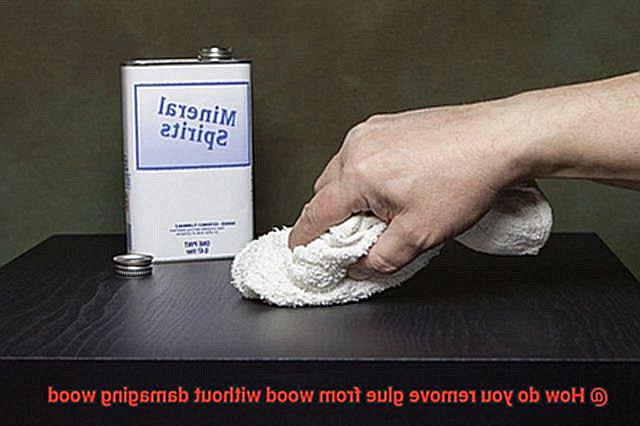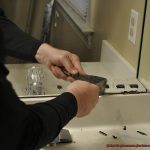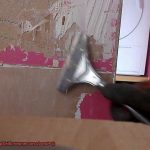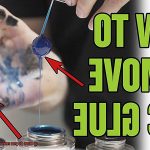Are you sick and tired of sticky glue stains ruining the gorgeous wood in your home?
Trust me, we’ve all been there. Whether it’s a mishap during an arts and crafts session or an old piece of furniture with globs of adhesive stuck to it, there’s no need to panic.
Removing glue from wood might sound like a nightmare, but don’t fret. In this blog post, we’ll dive into some foolproof techniques that will help you bid farewell to those stubborn marks without harming your precious wooden treasures.
Say goodbye to stickiness and hello to stunningly restored wood.
Common Methods to Remove Glue from Wood
Contents
- 1 Common Methods to Remove Glue from Wood
- 2 a. Heat
- 3 b. Solvents
- 4 c. Natural Remedies
- 5 Mechanical Methods for Stubborn Glue
- 6 Safety Precautions When Removing Glue
- 7 Different Types of Glues Requiring Specific Removal Methods
- 8 Testing the Method on a Small, Inconspicuous Area First
- 9 Preserving the Integrity and Beauty of the Wood Surface
- 10 Advantages and Disadvantages of Each Method
- 11 Conclusion
Removing glue from wood surfaces can be a challenging task. Whether you’re dealing with adhesive residue, dried-on glue, or sticky messes, knowing the common methods for safely removing glue without causing damage is essential. In this expert’s guide, we will explore various techniques that professionals use to effectively remove glue from wood.
Method 1: Applying Heat
One popular method for loosening glue from wood is applying heat. Using a hairdryer or heat gun, gently heat the glue until it softens. Carefully scrape off the softened glue using a plastic scraper or putty knife. Be cautious not to overheat the wood, as excessive heat can cause damage.
Method 2: Utilizing Solvents
Solvents are effective in dissolving different types of glues. Acetone is commonly used for removing super glue, while mineral spirits or denatured alcohol can tackle adhesive residue. Before applying any solvent, perform a small test on an inconspicuous area of the wood to ensure it won’t cause damage. Apply the solvent to a clean cloth and gently rub the glue until it starts to dissolve. Remember to work in a well-ventilated area and wear protective gloves and eye protection.
Method 3: Mechanical Removal
For stubborn or dried-on glue, mechanical methods such as sanding or scraping may be necessary. Use fine-grit sandpaper or a scraper tool to gently remove the glue, taking care not to scratch or damage the wood surface. Always sand in the direction of the wood grain for optimal results.
Method 4: Chemical Removers
In some cases, specialized chemical removers designed specifically for removing glue can be utilized. These removers are applied directly to the glue and left for a specific amount of time before being scraped off or wiped away. Always follow the instructions provided by the manufacturer to ensure safe and effective removal.
a. Heat
Glue spills and residue can be a real headache, tarnishing the beauty of your cherished wooden furniture or flooring. But fear not. In this comprehensive guide, we will delve into the enchanting world of heat-based glue removal. From the gentle warmth of a hairdryer to the steamy wonders of an iron, we have all the tools you need to bid farewell to sticky situations. So, without further ado, let’s embark on a journey through the captivating realm of heat.
Method 1: Harnessing Hairdryers or Heat Guns
One popular technique involves using the gentle breath of a hairdryer or the focused heat of a heat gun to delicately apply warmth to the glued area. Start with low heat and gradually increase if necessary. The mesmerizing power of heat softens the adhesive, making it pliable and easily removable without causing any harm to the wood. However, it is crucial to closely observe the wood’s response to prevent any warping or unsightly discoloration.
Method 2: Irons and Damp Cloths
For those stubborn glue spots that refuse to budge, grab an iron and a damp cloth. Place the damp cloth over the affixed area and set your iron to a low temperature. As you glide the iron over the cloth, a tantalizing dance begins—the steam generated works its magic, tenderly softening the glue for effortless removal. Gently scrape or wipe away the softened adhesive with caution, revealing the natural allure of your wooden surface.
Working in Small Sections:
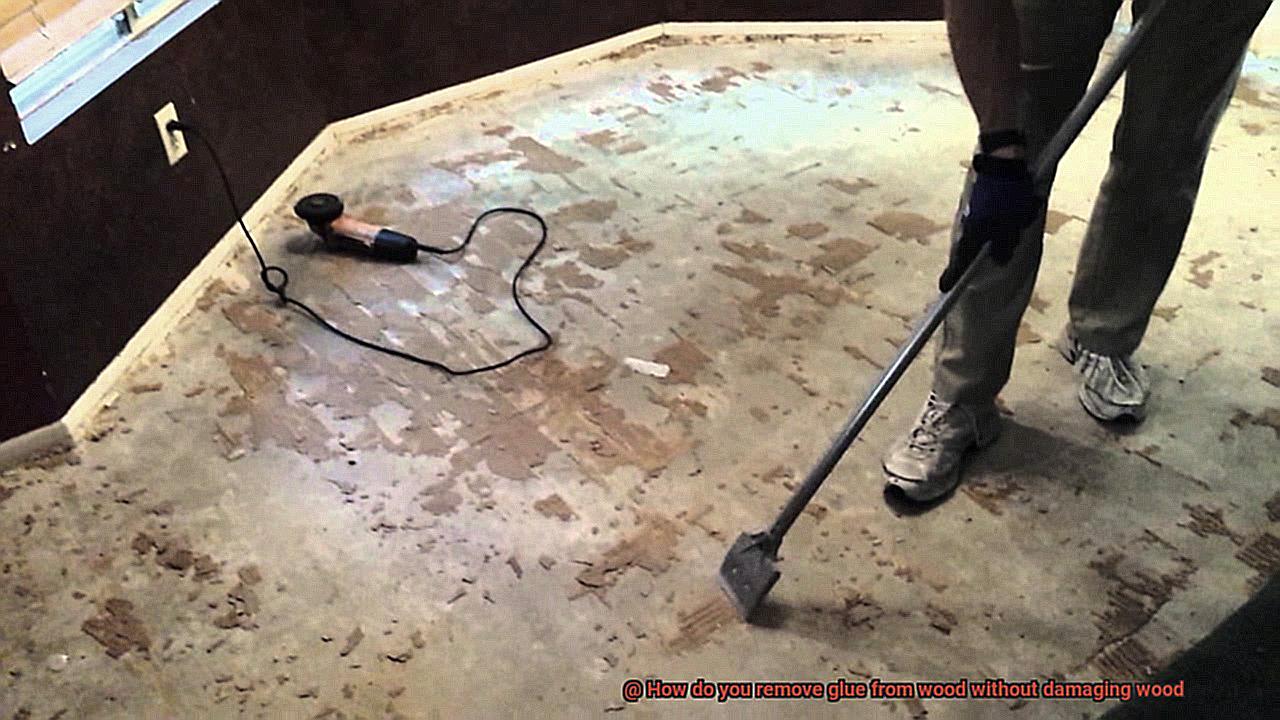
To safeguard against any potential damage, it is imperative to tackle one small section at a time when employing heat for glue removal. This meticulous approach allows for close monitoring of the wood’s reaction, enabling adjustments in technique if needed. Remember, patience is key—unveiling the hidden beauty of your wood requires a gentle touch and careful attention.
Testing Before Applying Heat:
Before embarking on full-scale adhesive eradication, it is wise to conduct a small, inconspicuous test. This preliminary step allows you to assess how your specific wood type will respond to the heat, ensuring no lasting harm befalls your beloved surface. Prevention is always superior to cure.
b. Solvents
Imagine being in a sticky situation, desperately trying to remove glue from your beloved wooden surface without causing any damage. Fear not, for we have the solution to your adhesive woes. Solvents are the secret weapons in the battle against stubborn glue stains. Today, we will embark on an enchanting journey through the realm of solvents, exploring their different types that can work their magic on wood without leaving a trace. So, don your gloves and join us as we unstick the past.
Acetone: The Powerhouse of Solvents
First on our solvent adventure is acetone, the mighty warrior found in nail polish removers. Its power lies in its ability to break down chemical bonds in glue, making it easier to wipe away. However, wield this weapon with caution on wood surfaces as excessive use can strip away the finish.
Rubbing Alcohol: A Gentle Touch
For a milder approach, turn to rubbing alcohol—the gentle healer. Applied with a cloth or sponge and gently rubbed onto the glued area, rubbing alcohol dissolves the glue without damaging the wood. Keep in mind that it may not be as effective on stronger adhesives or aged glue stains.
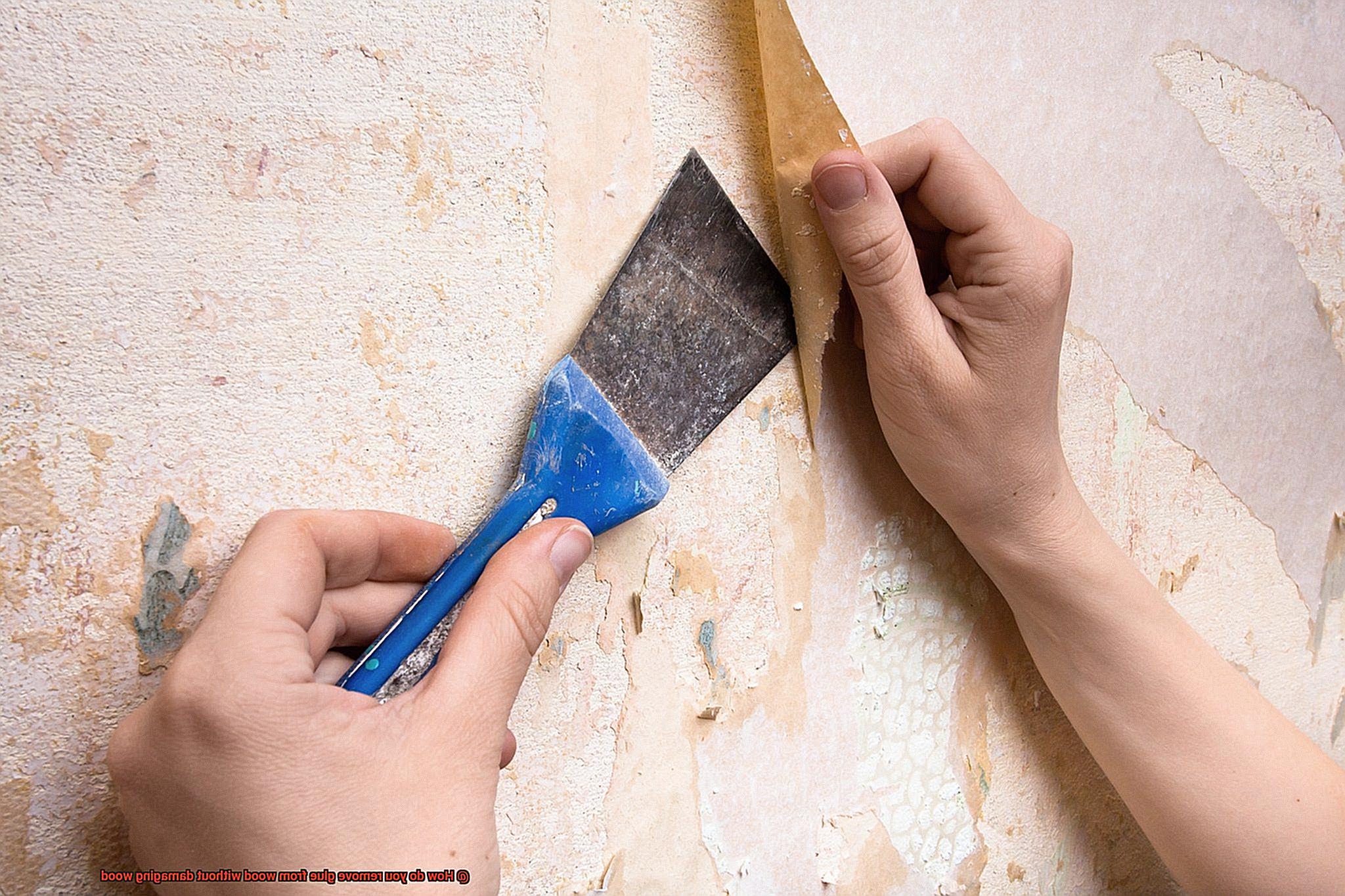
White Vinegar: Nature’s Remover
If you prefer a natural alternative, let white vinegar be your ally. This safe and eco-friendly solvent can be applied directly to the adhesive and left for a few minutes before wiping away. For stubborn glue stains, multiple applications may be required.
Citrus-based Solvents: A Zesty Solution
Last but not least, we have citrus-based solvents like orange oil or lemon oil. These aromatic solvents contain natural compounds that effectively break down adhesives without harming the wood surface. Simply apply them using a cloth or sponge, let them work their magic for a few minutes, and wipe away the softened glue.
c. Natural Remedies
These eco-friendly alternatives not only get the job done but also protect the integrity of your beautiful wooden surfaces. So, let’s dive into the world of natural remedies and explore some powerful solutions that will make that pesky glue disappear without a trace.
First up, let’s harness the power of heat. Grab a hot cloth or your trusty hairdryer set on medium heat. Apply the heat to the glue, and watch it soften like magic. Once it’s nice and pliable, grab a plastic scraper or even a credit card and gently scrape away the glue. Easy peasy.
But wait, there’s more. Our acidic allies, vinegar and lemon juice, are here to save the day. Soak a cloth in vinegar or lemon juice, apply it to the glue, and let it sit for a few minutes. Then wipe away the softened glue with ease. The natural acidity works wonders in breaking down that stubborn adhesive.
Now, let’s mix things up with baking soda and water. Create a paste by combining these two magical ingredients until you have a thick consistency. Apply it to the glue, let it sit for about 15 minutes, and then gently scrub the area with a soft brush or cloth. Voila. The glue will vanish before your very eyes.
But hold on, we’re not done yet. Some DIYers swear by using mayonnaise or peanut butter to remove glue from wood. The oils in these tasty treats can help break down the adhesive. Simply apply a small amount of mayo or peanut butter to the glue, let it sit for a few minutes, and wipe away the softened glue with a cloth.
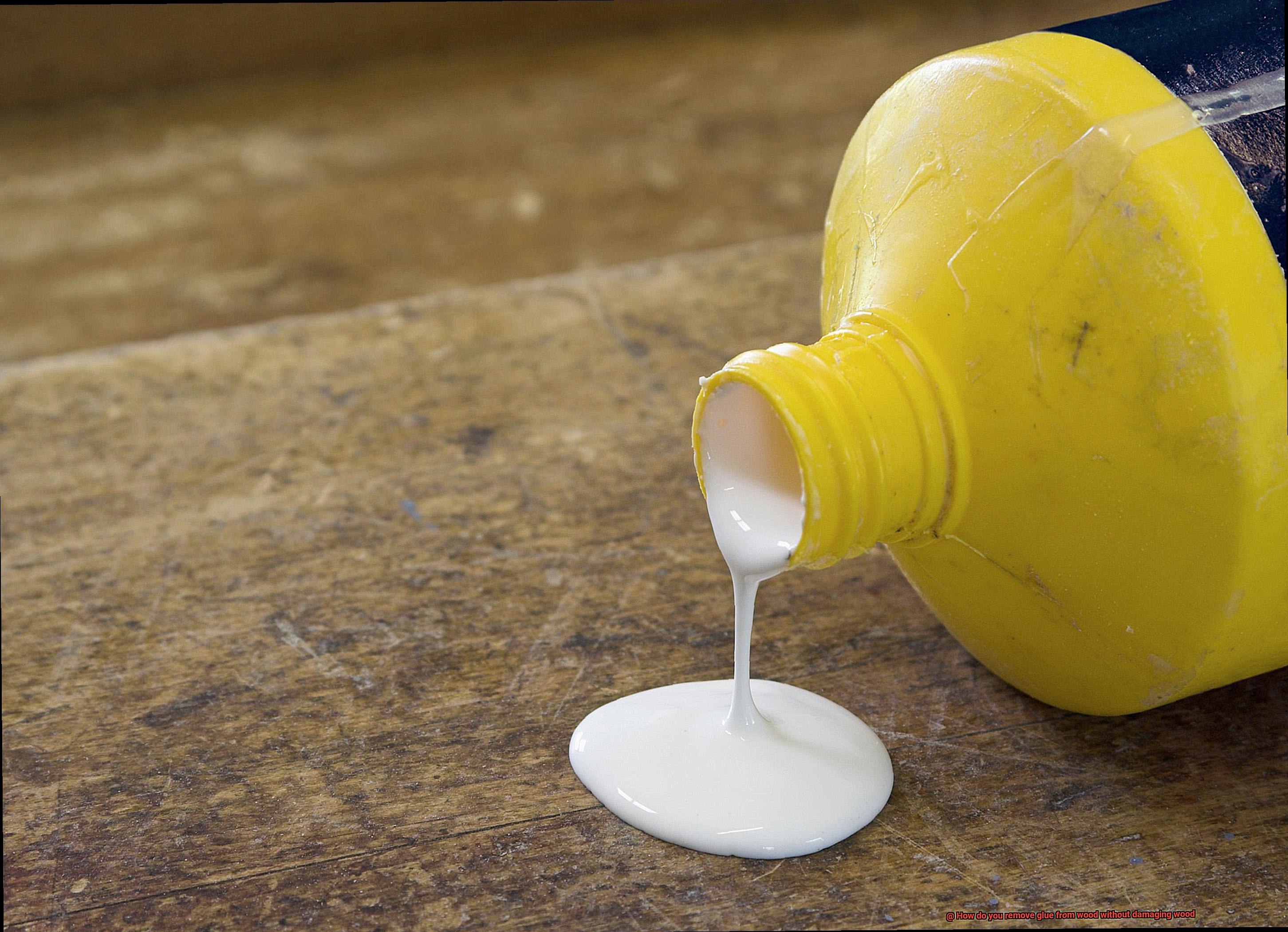
However, it’s important to note that not all natural remedies work universally on every type of glue or wood surface. To avoid any mishaps, test any method on a small, inconspicuous area first. And remember, be gentle. Excessive rubbing or scrubbing could potentially damage the wood surface.
Mechanical Methods for Stubborn Glue
Wood surfaces can add a touch of elegance and warmth to any space, but stubborn glue stains can tarnish their beauty. Fear not. There are mechanical methods that can effectively remove glue from wood without causing damage. In this comprehensive guide, we will explore the various mechanical methods available to tackle this problem head-on and restore your wood surfaces to their former glory.
Putty knife or scraper:
- Hold the tool at a slight angle and apply gentle pressure on the glue.
- Skillfully work your way underneath the glue, gradually lifting it up in small sections.
- Exercise caution to avoid unsightly scratches or dents on the wood.
Sandpaper or sanding blocks:
- Begin with coarse-grit sandpaper to delicately sand away excess glue.
- Move in the direction of the wood grain, preserving its natural pattern while preventing unsightly scratches.
- Progressively switch to finer-grit sandpaper until the surface is impeccably smooth and free from any glue remnants.
Power sander:
- Utilize a low grit sandpaper initially, gradually transitioning to higher grits for an impeccable finish.
- Exercise precision and care to prevent unintended damage.
- Regularly assess your progress to avoid over-sanding and maintain the integrity of the wood.
Heat application:
- Harness the power of a hairdryer on its highest heat setting to gently warm up the glue.
- Maintain a distance of a few inches between the hairdryer and the glue, moving it in a fluid back-and-forth motion.
- Once softened, gingerly lift off the glue with a putty knife or scraper, revealing pristine wood beneath.
Safety Precautions When Removing Glue
Today, we embark on a quest to liberate your beloved wood surfaces from the clutches of stubborn glue stains. But fear not, for I shall share with you the secrets of safety precautions to ensure a successful and hazard-free glue removal process.
Gear Up for Glory:
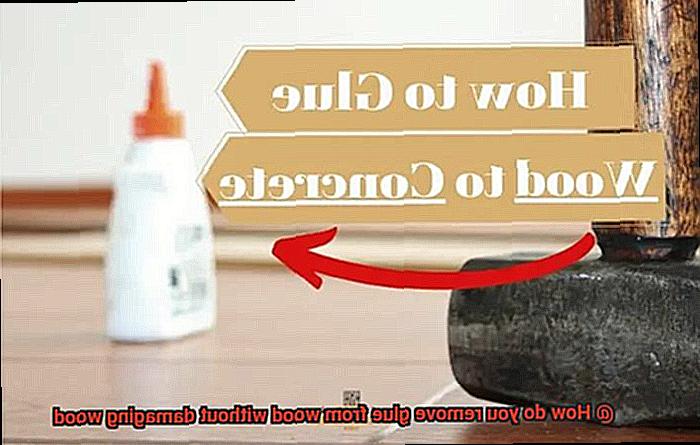
Before delving into the magical realm of glue removal, don your protective gear. Shield your hands from chemical reactions and skin irritation by wearing gloves. And don’t forget to adorn your eyes with safety goggles to prevent any unexpected glue or solvent splashes from turning your adventure into a tearful affair.
Breathe Easy in a Well-Ventilated Space:
Ventilation is the key to a safe and healthy environment. Make sure you work in a well-ventilated area to minimize exposure to harmful fumes and prevent the buildup of toxic vapors. Open windows or use fans to create an airy sanctuary where both you and your wood can breathe freely.
The Art of Reading Labels:
Ah, the ancient wisdom of reading labels. Different glue removers may have specific instructions and precautions. Take a moment to decipher these ancient scrolls and follow the recommended guidelines provided by the manufacturer. This will ensure that you wield your magic potions correctly, reducing any potential risks.
Test Your Spells:
In the realm of wood restoration, it is always wise to test your spells before casting them upon your precious wood surface. Apply a small amount of glue remover in an inconspicuous area first. Observe closely to ensure it doesn’t cause any damage or discoloration. Once you’ve confirmed its safety, you can unleash its power with confidence.
Gentle Tools and Techniques:
Remember, dear adventurer, that patience and gentleness are virtues when removing glue from wood. Choose the right tools for the task at hand. Opt for a plastic scraper instead of a metal one to prevent scratches or gouges on the wood’s delicate surface. Be gentle and take your time, ensuring that every stroke removes the glue without unintentional harm.
Cleanse the Glue’s Remnants:
After successfully vanquishing the glue, it’s time to cleanse the wood’s surface from any residue or excess adhesive. Wipe away these remnants with a soft cloth dampened with water or a mild cleaning solution. By doing so, you maintain the wood’s integrity and prevent any lingering chemicals from causing long-term damage.
Dispose with Care:
As your magical journey comes to an end, remember to dispose of any waste materials responsibly. Rags and containers used during the glue removal process may be considered hazardous waste, so check your local regulations for proper disposal methods. Protecting both nature and its inhabitants is a noble quest for any true wood restoration enthusiast.
Different Types of Glues Requiring Specific Removal Methods
When it comes to working with wood, glue is a valuable tool. However, what do you do when you need to remove the glue? Different types of glues require specific removal methods to ensure that the wood surface remains undamaged. In this blog post, we will delve into the various types of glues commonly used on wood surfaces and their respective removal techniques.
Woodworking Glue:
Woodworking glues, such as carpenter’s glue or wood glue, are water-based and can be softened by applying warm water or steam. To remove woodworking glue from wood, start by dampening a cloth or sponge with warm water and gently rub the glued area. This allows the glue to loosen its grip on the wood fibers. After a few minutes, use a plastic scraper or putty knife to carefully lift off the softened glue. The warm water method is effective for removing woodworking glue without causing any damage to the wood surface.

Epoxy Adhesive:
Epoxy adhesive forms an incredibly strong bond that requires a different approach for removal. To remove epoxy from wood, you can use a heat gun or hairdryer on its highest setting to soften the adhesive. Apply heat to the glued area, being cautious not to overheat the wood. Once the epoxy is pliable, gently scrape it off with a plastic scraper or putty knife. The heat method effectively loosens the bond of epoxy adhesive, making it easier to remove without damaging the wood surface.
Super Glue:
Super glue or cyanoacrylate adhesives bond quickly and firmly, making them challenging to remove without causing damage. Acetone or nail polish remover containing acetone can help dissolve super glue. Apply a small amount of acetone on a cotton ball or cloth and dab it onto the glued area. Allow it to soak for a few minutes, then gently scrape off the softened glue with a plastic scraper. The use of acetone effectively breaks down the super glue, allowing for its safe removal from the wood surface.
Construction Adhesive:
Construction adhesive and polyurethane adhesive create strong bonds that often require more aggressive removal methods. Look for solvents specifically designed to dissolve these adhesives. Apply the solvent to the glued area and allow it to penetrate. Use a plastic scraper or putty knife to remove the softened adhesive. Repeat if necessary. The use of adhesive-specific solvents effectively breaks down the construction adhesive, allowing for its removal without causing damage to the wood surface.
Testing the Method on a Small, Inconspicuous Area First
Don’t despair when faced with the task of removing glue from your precious wood surfaces. With one simple yet vital step – testing the glue removal method on a small, inconspicuous area first – you can ensure effectiveness while safeguarding the integrity of your wood. Join me as we delve into the significance of this preliminary test and uncover tips for successful glue removal.
The Importance of Testing:
Picture this: you apply a glue removal solution to your beloved wooden surface, only to discover it irreparably discolored or damaged. Testing the method on a small, inconspicuous area eradicates such nightmares. Different glues and wood types can react uniquely to various removal methods, making it imperative to evaluate their compatibility before proceeding further.
Tips for Testing:
- Choose an inconspicuous area: Opt for the underside of a table or the back of a cabinet as your testing spot. These areas won’t compromise the wood’s aesthetic appeal.
- Gently apply the glue removal solution: Use a cloth or sponge to gently apply a small amount of the solution onto the test area. Adhere to any manufacturer’s instructions regarding application time.
- Observe any adverse reactions: After the specified time has elapsed, wipe away the removal solution with a clean cloth or sponge. Scrutinize the test area for signs of damage like discoloration or changes in texture.
- Exercise caution and adapt accordingly: If no negative effects are discernible, proceed confidently. However, if adverse reactions manifest, stop immediately and consider alternative methods or seek professional guidance.
Further Considerations:
Even if the test area appears unscathed, remember that different sections of wood may react differently. Furthermore, specific glues may necessitate specialized removal techniques that may not be suitable for all wood types. Extensive research on the glue and wood combination, as well as recommended removal methods, is always advisable.
Preserving the Integrity and Beauty of the Wood Surface
Preserving the integrity and beauty of the wood surface is paramount when it comes to removing glue without causing any damage or blemishes. Glue residue can be an eyesore, potentially leading to discoloration or staining if not addressed properly. Fortunately, there are several effective methods available for removing glue from wood surfaces while ensuring that the natural beauty of the wood is preserved.
Testing is the first step in this process. Before applying any glue removal method, always test it on a small, hidden area of the wood. This detective-like investigation will help determine whether the method is safe to use without causing any damage or discoloration. Remember, prevention is always better than cure.
Once testing is complete, you can explore various techniques for removing glue from wood surfaces. One popular method is using heat. By gently applying heat from a hairdryer or heat gun to the affected area, the glue softens and becomes easier to remove. However, it’s important to keep the heat source moving constantly and avoid concentrating it in one spot for too long to prevent accidental damage.
If heat alone doesn’t do the trick, solvents or adhesive removers specifically designed for wood surfaces can come to your rescue. These products come in various forms such as gels, liquids, or sprays. Just like with heat, it’s crucial to test them on a small area before applying them liberally. Once confirmed safe, follow the manufacturer’s instructions and gently scrub away the stubborn glue residue using a clean cloth or sponge.
For particularly challenging glue spots, mechanical methods may be required. Plastic scrapers or putty knives are your best friends in these situations. Carefully scrape away the glue without scratching the precious wood surface. Remember, plastic tools are key – metal tools could cause unintended damage.
In cases where scraping isn’t sufficient, sanding can be your secret weapon. Start with a fine-grit sandpaper and gradually increase the coarseness if needed. However, it’s crucial to sand gently and evenly to avoid creating uneven patches on the wood.
Regardless of the method chosen, patience is key. Rushing or using excessive force can lead to unintended consequences like scratches, dents, or discoloration. Take your time, start with the gentlest method first, and only progress to more aggressive techniques if necessary.
Once the glue is successfully removed, don’t forget to give the wood surface a thorough cleaning to ensure no residue or solvents remain. This final step guarantees a pristine and beautiful result.
Advantages and Disadvantages of Each Method
Removing glue from wood can be tricky, but fear not. There are several methods you can try that will effectively remove the glue without causing any damage to the wood. Let’s take a closer look at the advantages and disadvantages of each method, so you can choose the best one for your needs.
The first method we’ll explore is the heat method. This approach involves using heat to soften the glue, making it easier to remove. One advantage of this method is its versatility. It works well on both water-based and solvent-based adhesives, so compatibility is not an issue. Additionally, heat can be applied using various tools like a hairdryer or heat gun, giving you flexibility in choosing the right tool for the job. However, excessive heat can potentially damage the wood, so caution is necessary. Regulating the temperature and avoiding prolonged exposure are crucial.
Next up is the solvent method. This method involves using chemicals or solvents to dissolve the glue and facilitate its removal. One advantage of this approach is its effectiveness in removing strong adhesives like epoxy or construction adhesive. Solvents can break down the glue without causing significant damage to the wood surface. However, some solvents may have a strong odor and require proper ventilation during application. Additionally, not all solvents may be suitable for all types of wood finishes, so it’s essential to test them on a small, inconspicuous area first.
If you’re looking for a safer option that doesn’t involve chemicals or heat, the mechanical method might be the way to go. This method involves physically scraping or sanding off the glue from the wood surface. One advantage of this approach is that it allows for precise control and can be effective in removing stubborn or thick layers of glue. Plus, there’s no need to worry about potential hazards associated with chemicals or heat. However, be careful not to apply too much pressure or use abrasive tools that can potentially damage the wood.
Lastly, there are natural remedies that can be used to remove glue from wood. Vinegar or lemon juice can be applied to soften the glue, while baking soda or toothpaste can act as gentle abrasives to help lift the adhesive. One advantage of using natural remedies is their availability and minimal health risks. However, keep in mind that they may not be as effective on certain types of glue or hardened adhesive residues.
bBOGArZpF4A” >
Also Read: How To Remove Glue From Wood Furniture?
Conclusion
Removing glue from wood without causing damage can be a tricky task, but with the right approach, it is definitely achievable. One method you can try is using heat to soften the glue. You can do this by using a hairdryer or a heat gun on a low setting and directing the heat towards the glue. As the glue begins to soften, you can gently scrape it off with a plastic scraper or an old credit card. Be careful not to apply too much heat or press too hard, as this could potentially damage the wood surface.
Another option is to use a solvent or adhesive remover specifically designed for removing glue. These products are readily available at most hardware stores and are formulated to break down and dissolve adhesives without harming the wood. Apply the solvent to a clean cloth and gently rub it onto the glued area. Allow it to sit for a few minutes to allow the solvent to penetrate the adhesive, then use a soft cloth or sponge to wipe away the softened glue.
If you prefer a more natural approach, you can also try using household items like vinegar or rubbing alcohol. Simply dampen a cloth with either of these substances and gently rub them onto the glue until it starts to loosen. Again, be cautious not to scrub too hard or use excessive force that could mar the wood.
Once you have successfully removed all traces of glue, make sure to thoroughly clean and dry the wood surface before applying any finishes or treatments. This will ensure that your wood remains in pristine condition.
Remember, patience is key when removing glue from wood without causing damage. Take your time and proceed cautiously, always testing any method on an inconspicuous area first before applying it to larger portions of your wooden surface.
In conclusion, there are several effective methods for removing glue from wood without damaging its surface. Whether you choose to use heat, solvents, or household items like vinegar or rubbing alcohol, always exercise caution and take your time.

